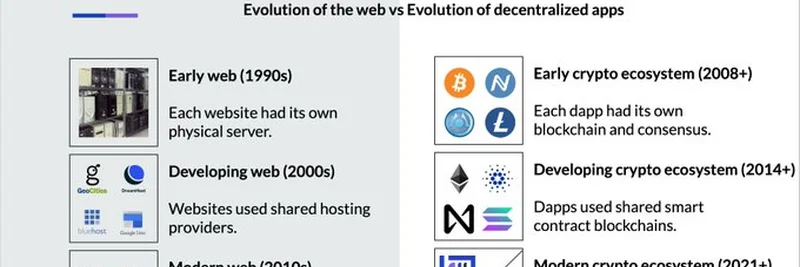Hey there, crypto enthusiasts! If you’ve been keeping an eye on the latest trends in the blockchain world, you’ve probably come across Nick White’s recent tweet from July 7, 2025. This post throws back to an old slide from when Celestia was still called LazyLedger, hinting at its ambitious goal to become the "AWS of Web3." Let’s break it down and see what this means for the future of decentralized applications (dApps)!
What’s in the Slide?
The image Nick shared compares the evolution of the web with the evolution of decentralized apps. It’s a neat visual that shows how both have moved from isolated systems to shared, efficient infrastructures. Here’s a quick rundown:
- Early Web (1990s): Each website had its own physical server—think of it like every house having its own power plant!
- Developing Web (2000s): Shared hosting providers like GeoCities and Bluehost stepped in, making things more efficient.
- Modern Web (2010s): Big players like AWS and Google Cloud introduced virtual machines, sharing physical hardware across millions of sites.
Now, let’s flip to the crypto side:
- Early Crypto Ecosystem (2008+): Each dApp, like Bitcoin or Litecoin, had its own blockchain and consensus mechanism—independent and standalone.
- Developing Crypto Ecosystem (2014+): Smart contract blockchains like Ethereum and Solana allowed dApps to share infrastructure.
- Modern Crypto Ecosystem (2021+): Enter app-specific chains that share consensus layers, with Celestia leading the charge.
Celestia: The AWS of Web3?
Nick White, a key figure in the Celestia community, calls this vision "AWS for Web3." Just like AWS revolutionized the web by providing scalable, on-demand computing resources, Celestia aims to do the same for blockchain. Instead of developers building everything from scratch, Celestia offers a modular blockchain network where you can deploy your own chain as easily as deploying a smart contract. This means more flexibility, better scalability, and a thriving ecosystem of interconnected blockchains.
The idea is simple but powerful: separate the consensus layer (the "agreement" part) from the execution layer (where the code runs). This modularity lets developers focus on building dApps without worrying about the heavy lifting of maintaining a full blockchain. Pretty cool, right?
Why It Matters
This evolution mirrors how the internet grew from clunky servers to sleek cloud solutions. For blockchain practitioners, Celestia’s approach could mean faster development cycles and lower costs. Plus, with projects like Doma tokenizing internet domains and Towns building onchain communication layers, we’re seeing real-world use cases take shape. The slide’s nod to "abundant throughput" suggests Celestia is gearing up to tackle crypto’s scaling bottlenecks—something every meme token enthusiast and serious developer should watch.
The LazyLedger Legacy
Fun fact: Celestia wasn’t always called that! It started as LazyLedger, a name that highlighted its minimalist design. The rebrand to Celestia (meaning "heavenly") reflects a broader, more inspiring vision—think of it as blockchains forming constellations in the sky. This shift underscores the project’s goal to connect and empower a diverse ecosystem, much like the stars in a galaxy.
What’s Next for Celestia?
With events like Modular Bangkok on the horizon, the community is buzzing. Developers are diving into workshops to explore Celestia’s potential, and the roadmap promises scalability beyond 1 GB/s. If Celestia delivers, it could redefine how we think about dApps and meme tokens alike. So, keep an eye on meme-insider.com for the latest updates—we’ll be tracking this space closely!
What do you think about Celestia’s vision? Drop your thoughts in the comments, and let’s chat about how this could shape the future of Web3!



